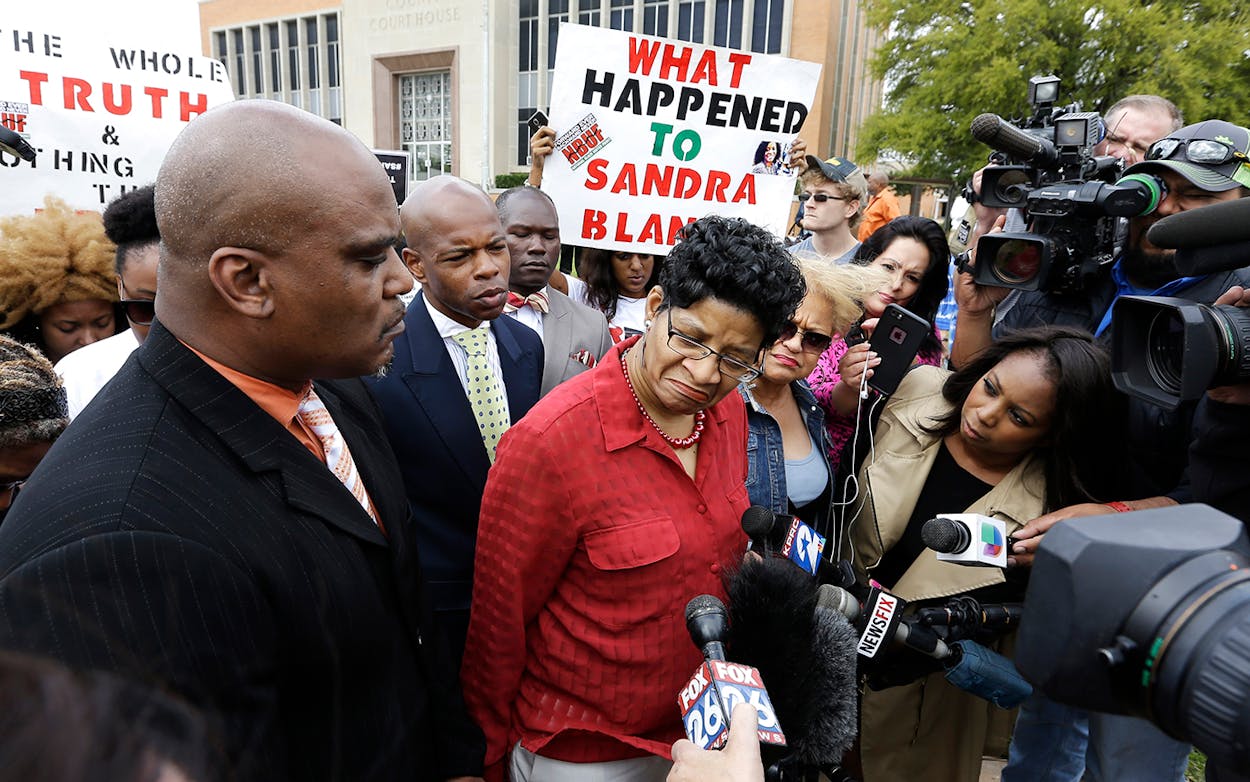It’s been almost four years since the death of Sandra Bland. The incident that led to her death has been well documented. The footage of the traffic stop, recorded both by a bystander and from the dashboard of former Texas Department of Public Safety patrolman Brian Encinia, has been viewed millions of times. In the full video, what you see is a patrolman who grows furious when Bland refuses to put out her cigarette. The escalation in the video is rapid—Encinia tells Bland that she’s under arrest, though declines to tell her why. She tells him she intends to call her lawyer, at which point he produces a taser and screams, “I will light you up” at the woman—and, in the video recorded by the bystander, Bland is down on the ground later in the stop. She was arrested and taken to the Waller County Jail, where hey body was found in its cell, the result of what jail officials called a suicide.
Those videos are infamous, but WFAA has another one—it’s the video shot by Bland herself, from the most heated moments of the encounter.
The circumstances of Bland’s death raised questions around the country. People demonstrated in sweltering heat outside of the Waller County Jail where she died for a number of weeks after her death, seeking to understand what happened. The initial traffic stop was a result of a failure to signal while changing lanes, and many have struggled to understand how the fiery, defiant woman captured in the footage could have ended her life by suicide just days later. Many details of the arrest and of Bland’s incarceration were questioned. Toxicology reports indicated that Bland may have been given access to drugs while she was incarcerated. Six months after the arrest, in January 2016, Encinia was charged with perjury for suspicion of falsifying his police report. (The following year, the charges were dropped on the condition that Encinia never again seek work in law enforcement, and that he not attempt to have the arrest expunged from his record.)
It’s not rare for law enforcement officials who’ve been fired by city police to find work in the same field, despite such allegations. In fact, Waller County sheriff Glenn Smith, whose department oversees the jail (and oversaw the subsequent investigation into Bland’s death), had previously been fired from his job as the chief of police in Hempstead, the city in which the jail is located, over allegations of police misconduct, including racism. That situation isn’t an outlier, either—in the East Texas town where James Byrd was murdered in 1999, a City of Jasper police officer who was fired in 2013 after video captured him assaulting a black woman in custody was rehired by the county of Jasper. In 2014, when Victoria police officer Nathaniel Robinson was fired after violently arresting a 76-year-old man he suspected of driving with an expired registration sticker, he was rehired in nearby Beeville.
Practices like that are inherently tied into the conversation around Sandra Bland’s death, and it means that new footage of her encounter with Encinia, which can be contrasted, yet again, with the description of the arrest he detailed in his official report, has the potential to have an impact once more.
In 2017, Texas passed the Sandra Bland Act, which requires—among other provisions—deescalation training for police in the state and for police departments to release data on their traffic to the public. What we’ve learned from the latter, thanks to analysis by criminal justice activist Scott Henson, tells us that, in many parts of the state, the former isn’t always implemented. In Austin, 77 of every 10,000 traffic stops involve the use of force—more than 900 individual uses of forces in 2018 alone (in San Antonio, a city with more traffic stops, that number was just 57). In Waco, one out of every 22 traffic stops ends in an arrest on a Class C misdemeanor, while Longview and Lufkin both approach 5 percent of their stops resulting in an arrest for a previous warrant—a category that can include an unpaid ticket.
In other words, despite having a law bearing her name, despite the officer who carried out the arrest avoiding criminal charges only by promising to never again pursue law enforcement work, despite the still-unanswered questions about how she ended up in a position to be found dead in her cell, the direct impact of Bland’s death on the way traffic stops are carried out in Texas is still not as substantial as it could be. That said, this week the Texas House will vote on a bipartisan measure that was stripped from the 2017 Sandra Bland Act. The bill would limit the authority of police to arrest motorists on Class C misdemeanor charges (the bill features an exception for public intoxication, assault, and situations where the driver presents “a clear and immediate danger”). That this comes the same week that lawmakers—and their constituents—are getting a fresh reminder of what happened to Sandra Bland when she was arrested for “contempt of cop” seems somehow appropriate. Bland’s death was and is a tragedy, but if we’re now able to see what the encounter that led up to it looked like from her perspective, perhaps we’ll also see legislators enact a measure that will make future arrests like it illegal.
- More About:
- Crime
- Sandra Bland








